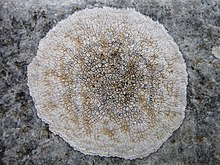Circinaria calcarea
| Circinaria calcarea | |
|---|---|

| |
| Scientific classification | |
| Domain: | Eukaryota |
| Kingdom: | Fungi |
| Division: | Ascomycota |
| Class: | Lecanoromycetes |
| Order: | Pertusariales |
| Family: | Megasporaceae |
| Genus: | Circinaria |
| Species: | C. calcarea
|
| Binomial name | |
| Circinaria calcarea (L.) A.Nordin, Savić & Tibell 2010
| |
| Synonyms[1] | |
| |
Circinaria calcarea is a species of crustose lichen in the family Megasporaceae. It was first described as a new species by Carl Linnaeus in his 1753 work Species Plantarum. Linnaeus named it Lichen calcareus, as he classified all lichens in the eponymously named genus.[2] The species has had an extensive taxonomic history, resulting in dozens of synonyms.[1] In 2010, it was placed in its current genus, Circinaria, following molecular phylogenetic analysis of the Megasporaceae.[3]
Circinaria calcarea has a cosmopolitan distribution, having been recorded from the Arctic, Asia, Australasia, Europe, Oceania, Central America, South America, and North America. It is a saxicolous lichen, and grows on calcareous, calciferous, and basic rock.[4]
References
- ^ a b "Synonymy: Circinaria calcarea (L.) A. Nordin, Savić & Tibell, Mycologia 102(6): 1341 (2010)". Species Fungorum. Retrieved 12 November 2021.
- ^ Linnaeus, Carl (1753). Species Plantarum (in Latin). Vol. 2. Stockholm: Impensis Laurentii Salvii. p. 1169. doi:10.5962/bhl.title.37656.
- ^ Nordin, Anders; Savić, Sanja; Tibell, Leif (2010). "Phylogeny and taxonomy of Aspicilia and Megasporaceae". Mycologia. 102 (6): 1339–1349. doi:10.3852/09-266. JSTOR 27920439.
- ^ "Circinaria calcarea (L.) A. Nordin, Savić & Tibell". Consortium of North American Lichen Herbaria. Retrieved 12 November 2021.
